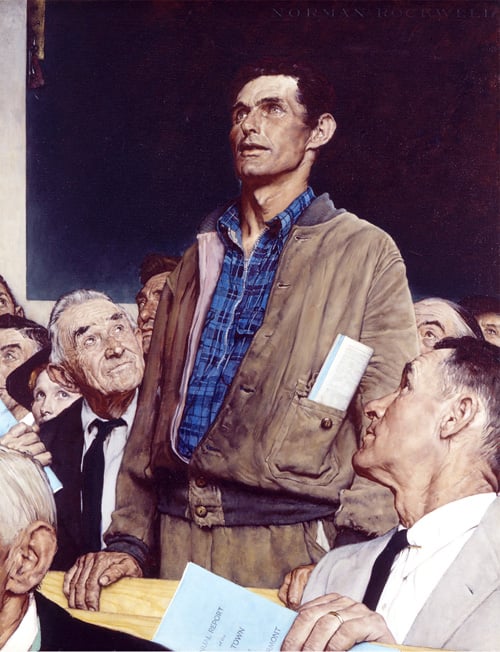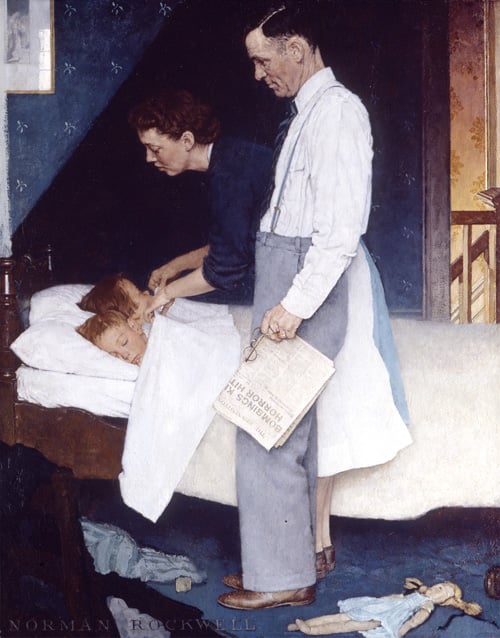Art & Exhibitions
Norman Rockwell’s ‘Four Freedoms’ Paintings to Go on First International Tour
The paintings are based on a famous State of the Union address.

The paintings are based on a famous State of the Union address.

Sarah Cascone

Norman Rockwell’s iconic “Four Freedoms” paintings, perhaps the best-known images ever created by the American artist, will be the subject of a massive travelling exhibition organized by the Norman Rockwell Museum in Stockbridge, Massachusetts.
The paintings illustrate President Franklin D. Roosevelt’s 1941 State of the Union address, which is based around the idea that people “everywhere in the world” have the right to enjoy four fundamental freedoms: freedom of speech, freedom of worship, freedom from want, and freedom from fear.
Though revisiting these seminal works may seem especially timely given the current political climate, the show has been in the works for three years. The creation of the “Four Freedoms” series is “one of the great art stories of the past century,” Rockwell Museum director Laurie Norton-Moffatt told artnet News in a phone interview, noting that the paintings “continue to speak powerfully, not just in America, but around the world.”

Norman Rockwell, Freedom to Worship (1943) illustration for the Saturday Evening Post. Courtesy of the Norman Rockwell Museum Collections, © SEPS, Curtis Licensing.
Rockwell painted the images in response to a nationwide call for artists to illustrate the concepts of Roosevelt’s speech. “The government had spent months trying to communicate these soaring ideals of basic fundamental rights,” said Norton-Moffatt. “They were not connecting with the public to make citizens understand the importance of stepping into the war and defending freedom.”
The artist was also challenged by the task, until late one night, after attending a small town meeting in Vermont, it hit him. “It was the everyday moments in our lives that we maybe take for granted [or] that we don’t even see or recognize as special or unique” that truly define our freedoms as Americans, said Norton-Moffatt.
Rockwell’s town hall experience is depicted in the Freedom of Speech painting. “The ability to speak what’s on your mind, freedom of expression, whether that’s art or the press or in a town meeting or in any environment,” added Norton-Moffatt, is “one of the fundamental hallmarks of our country.”
Initially rejected by the government, the paintings were published for the first time in four successive issues of the Saturday Evening Post, between February 20, 1943, and March 13, 1943, to instant acclaim.

Norman Rockwell, Freedom from Want (1943) illustration for the Saturday Evening Post. Courtesy of the Norman Rockwell Museum Collections, © SEPS, Curtis Licensing.
“The pictures were immensely popular and they resonated with people; the letters were pouring in,” said Norton-Moffatt. “It’s hard to understand in this day of social media and instant communications and global television… but at the time before television, the magazine was the dominant purveyor distributor of visual images, and these images had an incredibly powerful impact on people.”
When the government saw this response, they changed their mind, officially licensing the images to help promote the war effort. In addition to being plastered across every post office in the country, the original large-scale, nearly life-size paintings went on a nationwide tour.
Now the centerpiece of the Rockwell Museum’s collection, the upcoming exhibition will mark the first time the original paintings have traveled in a generation. The upcoming tour will conclude in Normandy, France, which will be the first time the “Four Freedoms” will be exhibited internationally.
Accompanying the series will be a number of Rockwell’s later works, many of which were inspired by themes present in “Four Freedoms.”
“The exhibition takes this through-line through to the end of his career and looks at how his art continued to animate these ideas of social justice and humanitarianism,” said Norton-Moffatt, citing paintings created for the United Nations, Peace Corps, and the Civil Rights movement as examples.

Norman Rockwell, Freedom from Fear (1943) illustration for the Saturday Evening Post. Courtesy of the Norman Rockwell Museum Collections, © SEPS, Curtis Licensing.
The “Four Freedoms” paintings will be juxtaposed with other artists’ attempts to illustrate Roosevelt’s famous speech, as well as examples of nationalist World War II-era art from other countries embroiled in the global conflict. “The Axis and Allied powers all used propaganda art, mostly to demonize the enemy,” Norton-Moffatt noted. “I think what’s so distinguishing about Rockwell is that chose to illuminate what we cherish in our own life, and not portray other people as evil, but to say this is what we’re standing up to defend. It was a transformative idea and I think still compelling today to speak for something as opposed to against something.”
There will also be a juried open call for contemporary artists creating their own work based on the concept of freedom today. Notably, the “Four Freedoms” speech has already inspired the name for Eric Gottesman and Hank Willis Thomas’s artist-run super PAC For Freedoms, but the museum is quick to shy away from overt political activism.
“We did not create the exhibition for political purposes, we created it for humanitarian purposes,” Norton-Moffatt cautioned. “It’s really meant to spark ideas.”
“I hope,” she added, “it’s a thoughtful and inspiring vehicle for thinking about our fundamental human rights.”
“Enduring Ideals: Rockwell, Roosevelt & the Four Freedoms” will be on view at the New-York Historical Society, June–August 2018. It will then travel to the Henry Ford Museum in Dearborn, Michigan, October–December 2018; a to-be-announced Washington, DC, venue, February–April 2019; the Norman Rockwell Museum in Stockbridge, Massachusetts, June–August 2019; the National Constitution Center in Philadelphia, October–December 2019; the Museum of Fine Arts, Houston, February–April 2020; and the Memorial de Caen in Normandy, June–October 2020.